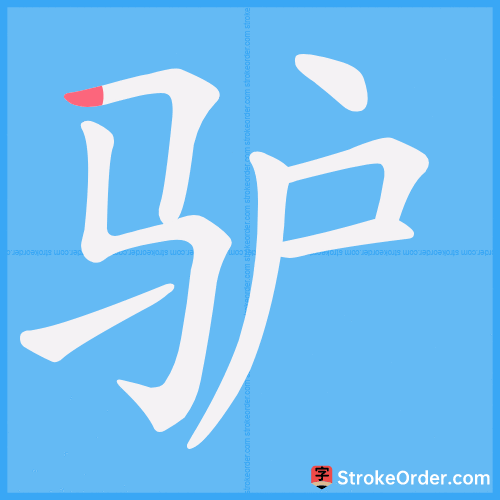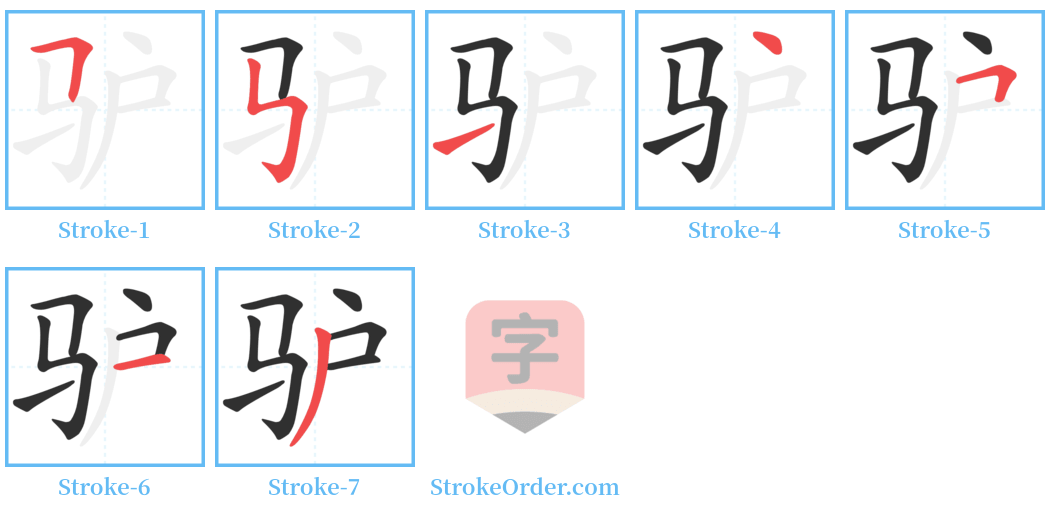驴 Stroke Order
Animated Stroke Order of 驴

Stroke Order Diagrams for 驴

Step-by-Step Handwriting Guide for 驴

Learn to Write Chinese Characters with Video Tutorials
Watch the video of writing the Chinese character "驴", learn the correct stroke order (笔顺) of the character "驴", and master the standard way of writing the character "驴".
Free Printable Handwriting Practice with Stroke Order: 驴
Printable Writing Practice Worksheet of "驴" in Portrait Orientation (Tian Zi Ge)

Printable Writing Practice Worksheet of "驴" in Landscape Orientation (Tian Zi Ge)

Information of 驴
Pinyin
lǘ
Radical
马
Strokes
7 strokes
Usage
★★★★★
Definition
donkey
驴 (lǘ)
1. A mammal resembling a horse but smaller, capable of carrying loads, pulling carts, plowing fields, and being ridden.
- Synonym: 驴子 (lǘzi), domestic animal name.
- Example: 驴骡 (lǘluó, donkey and mule), 驴皮胶 (lǘpíjiāo, also known as 阿胶, a type of gelatin).
- Related expression: 驴唇不对马嘴 (lǘchún bù duì mǎzuǐ, lit. the donkey's lips do not match the horse's mouth, meaning discordant or unrelated).
2. Same as the original meaning ([En.] ass; burro; donkey).
- Reference: 《说文》: 驴,似马,长耳. (In Shuo Wen: The donkey resembles a horse and has long ears.)
- Example: 贾谊《吊屈原文》: 腾驾罢牛,骖蹇驴兮 (in Jia Yi's work, referring to riding a donkey after riding a cow).
3. An insult or derogatory term.
- Examples:
- 驴头 (lǘ tóu, donkey's head, an insult).
- 驴王 (lǘ wáng, cruel or fierce person).
- 驴年 (lǘ nián, metaphor for something without a deadline).
- 驴券 (lǘ quàn, metaphor for speech lacking point).
- 驴颓 (lǘ tuí, crude term referring to male anatomy).
- 驴鸣犬吠 (lǘ míng quǎn fèi, referring to low quality writing).
4. A surname.
Overall, 驴 primarily refers to the donkey, a domesticated animal useful in agriculture and transport, and also carries various connotations in idioms and expressions, including insults and metaphors.
lit. a donkey's lips do not match a horse's mouth (idiom) / fig. beside the point / incongruous
Input Method for 驴
Pinyin
lv2
Wubi
cynt|cgyn
Cangjie
nmis
Zhengma
xwm
Four Corner
73107
Unicode
U+9a74
Same Pronunciation Characters